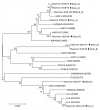Genotypic Heterogeneity of Orientia tsutsugamushi in Scrub Typhus Patients and Thrombocytopenia Syndrome Co-infection, Myanmar
- PMID: 32687023
- PMCID: PMC7392420
- DOI: 10.3201/eid2608.200135
Genotypic Heterogeneity of Orientia tsutsugamushi in Scrub Typhus Patients and Thrombocytopenia Syndrome Co-infection, Myanmar
Abstract
Serologic and molecular surveillance of serum collected from 152 suspected scrub typhus patients in Myanmar revealed Orientia tsutsugamushi of genotypic heterogeneity. In addition, potential co-infection with severe fever with thrombocytopenia syndrome virus was observed in 5 (3.3%) patients. Both scrub typhus and severe fever with thrombocytopenia syndrome are endemic in Myanmar.
Keywords: Bacteria; Myanmar; Orientia tsutsugamushi; co-infection; differential diagnosis genotypes; mite-borne infections; phylogenic analysis; scrub typhus; thrombocytopenia syndrome virus; tsutsugamushi; vector-borne infections; viruses.
Figures


References
-
- Davis GE, Austrian RC, Bell EJ. Observations on tsutsugamushi disease (scrub typhus) in Assam and Burma: the recovery of strains of Rickettsia orientalis. Am J Hyg. 1947;46:268–86. - PubMed
Publication types
MeSH terms
LinkOut - more resources
Full Text Sources

